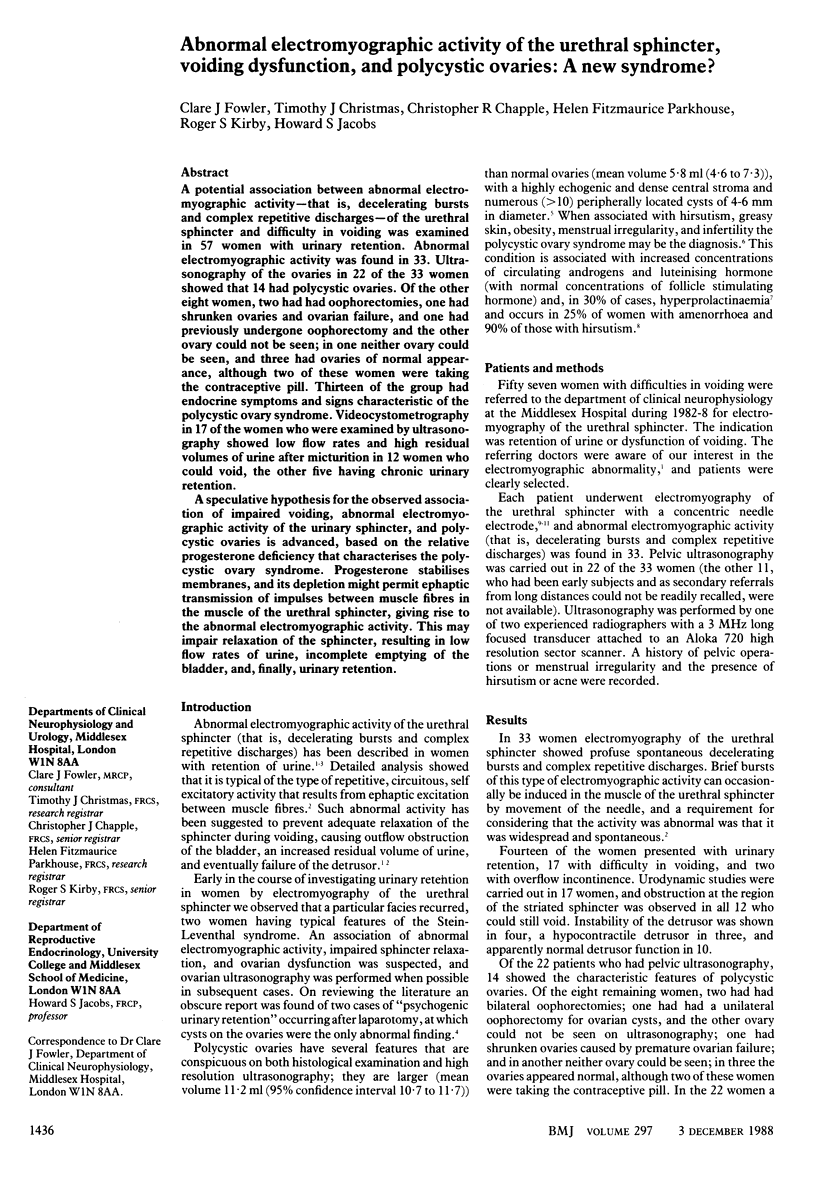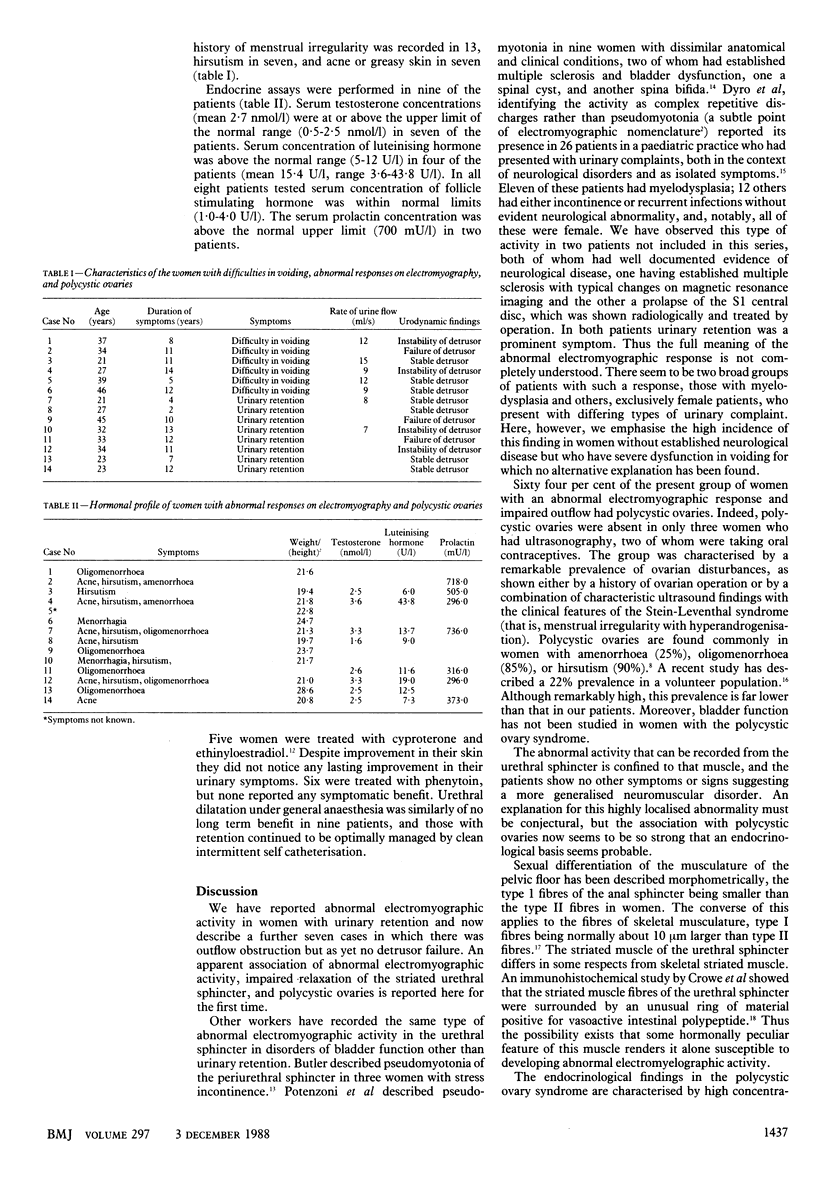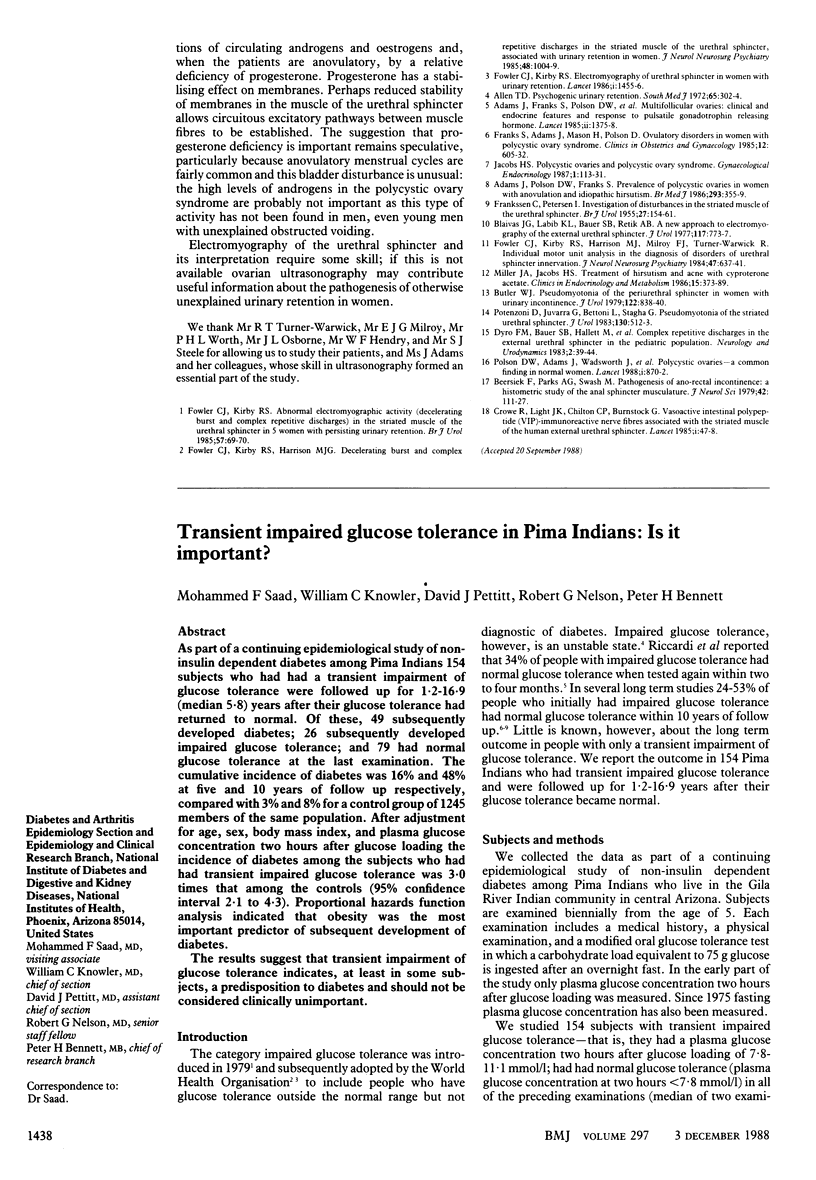Abstract
A potential association between abnormal electromyographic activity--that is, decelerating bursts and complex repetitive discharges--of the urethral sphincter and difficulty in voiding was examined in 57 women with urinary retention. Abnormal electromyographic activity was found in 33. Ultrasonography of the ovaries in 22 of the 33 women showed that 14 had polycystic ovaries. Of the other eight women, two had had oophorectomies, one had shrunken ovaries and ovarian failure, and one had previously undergone oophorectomy and the other ovary could not be seen; in one neither ovary could be seen, and three had ovaries of normal appearance, although two of these women were taking the contraceptive pill. Thirteen of the group had endocrine symptoms and signs characteristic of the polycystic ovary syndrome. Videocystometrography in 17 of the women who were examined by ultrasonography showed low flow rates and high residual volumes of urine after micturition in 12 women who could void, the other five having chronic urinary retention. A speculative hypothesis for the observed association of impaired voiding, abnormal electromyographic activity of the urinary sphincter, and polycystic ovaries is advanced, based on the relative progesterone deficiency that characterises the polycystic ovary syndrome. Progesterone stabilises membranes, and its depletion might permit ephaptic transmission of impulses between muscle fibres in the muscle of the urethral sphincter, giving rise to the abnormal electromyographic activity. This may impair relaxation of the sphincter, resulting in low flow rates of urine, incomplete emptying of the bladder, and, finally, urinary retention.
Full text
PDF


Selected References
These references are in PubMed. This may not be the complete list of references from this article.
- Adams J., Franks S., Polson D. W., Mason H. D., Abdulwahid N., Tucker M., Morris D. V., Price J., Jacobs H. S. Multifollicular ovaries: clinical and endocrine features and response to pulsatile gonadotropin releasing hormone. Lancet. 1985 Dec 21;2(8469-70):1375–1379. doi: 10.1016/s0140-6736(85)92552-8. [DOI] [PubMed] [Google Scholar]
- Adams J., Polson D. W., Franks S. Prevalence of polycystic ovaries in women with anovulation and idiopathic hirsutism. Br Med J (Clin Res Ed) 1986 Aug 9;293(6543):355–359. doi: 10.1136/bmj.293.6543.355. [DOI] [PMC free article] [PubMed] [Google Scholar]
- Allen T. D. Psychogenic urinary retention. South Med J. 1972 Mar;65(3):302–304. doi: 10.1097/00007611-197203000-00009. [DOI] [PubMed] [Google Scholar]
- Beersiek F., Parks A. G., Swash M. Pathogenesis of ano-rectal incontinence. A histometric study of the anal sphincter musculature. J Neurol Sci. 1979 Jun;42(1):111–127. doi: 10.1016/0022-510x(79)90156-4. [DOI] [PubMed] [Google Scholar]
- Blaivas J. G., Labib K. L., Bauer S. B., Retik A. B. A new approach to electromyography of the external urethral sphincter. J Urol. 1977 Jun;117(6):773–777. doi: 10.1016/s0022-5347(17)58622-x. [DOI] [PubMed] [Google Scholar]
- Butler W. J. Pseudomyotonia of the periurethral sphincter in women with urinary incontinence. J Urol. 1979 Dec;122(6):838–840. doi: 10.1016/s0022-5347(17)56629-x. [DOI] [PubMed] [Google Scholar]
- Crowe R., Light J. K., Chilton C. P., Burnstock G. Vasoactive intestinal polypeptide (VIP)-immunoreactive nerve fibres associated with the striated muscle of the human external urethral sphincter. Lancet. 1985 Jan 5;1(8419):47–48. doi: 10.1016/s0140-6736(85)90994-8. [DOI] [PubMed] [Google Scholar]
- FRANKSSON C., PETERSEN I. Electromyographic investigation of disturbances in the striated muscle of the urethral sphincter. Br J Urol. 1955 Jun;27(2):154–161. doi: 10.1111/j.1464-410x.1955.tb03459.x. [DOI] [PubMed] [Google Scholar]
- Fowler C. J., Kirby R. S. Abnormal electromyographic activity (decelerating burst and complex repetitive discharges) in the striated muscle of the urethral sphincter in 5 women with persisting urinary retention. Br J Urol. 1985 Feb;57(1):67–70. doi: 10.1111/j.1464-410x.1985.tb08988.x. [DOI] [PubMed] [Google Scholar]
- Fowler C. J., Kirby R. S. Electromyography of urethral sphincter in women with urinary retention. Lancet. 1986 Jun 28;1(8496):1455–1457. doi: 10.1016/s0140-6736(86)91497-2. [DOI] [PubMed] [Google Scholar]
- Fowler C. J., Kirby R. S., Harrison M. J. Decelerating burst and complex repetitive discharges in the striated muscle of the urethral sphincter, associated with urinary retention in women. J Neurol Neurosurg Psychiatry. 1985 Oct;48(10):1004–1009. doi: 10.1136/jnnp.48.10.1004. [DOI] [PMC free article] [PubMed] [Google Scholar]
- Fowler C. J., Kirby R. S., Harrison M. J., Milroy E. J., Turner-Warwick R. Individual motor unit analysis in the diagnosis of disorders of urethral sphincter innervation. J Neurol Neurosurg Psychiatry. 1984 Jun;47(6):637–641. doi: 10.1136/jnnp.47.6.637. [DOI] [PMC free article] [PubMed] [Google Scholar]
- Franks S., Adams J., Mason H., Polson D. Ovulatory disorders in women with polycystic ovary syndrome. Clin Obstet Gynaecol. 1985 Sep;12(3):605–632. [PubMed] [Google Scholar]
- Jacobs H. S. Polycystic ovaries and polycystic ovary syndrome. Gynecol Endocrinol. 1987 Mar;1(1):113–131. doi: 10.3109/09513598709082702. [DOI] [PubMed] [Google Scholar]
- Miller J. A., Jacobs H. S. Treatment of hirsutism and acne with cyproterone acetate. Clin Endocrinol Metab. 1986 May;15(2):373–389. doi: 10.1016/s0300-595x(86)80031-7. [DOI] [PubMed] [Google Scholar]
- Polson D. W., Adams J., Wadsworth J., Franks S. Polycystic ovaries--a common finding in normal women. Lancet. 1988 Apr 16;1(8590):870–872. doi: 10.1016/s0140-6736(88)91612-1. [DOI] [PubMed] [Google Scholar]
- Potenzoni D., Juvarra G., Bettoni L., Stagni G. Pseudomyotonia of the striated urethral sphincter. J Urol. 1983 Sep;130(3):512–513. doi: 10.1016/s0022-5347(17)51278-1. [DOI] [PubMed] [Google Scholar]


